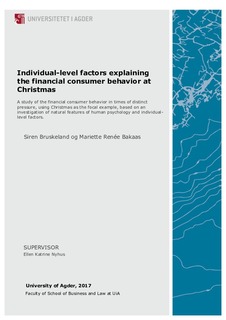| dc.description.abstract | The purpose of this thesis is to examine the individual-level factors related to financial
consumer behavior during times of distinct pressure, using Christmas and Christmas gifts as
focal examples. Additionally, we want to examine whether the Christmas-trade can lead to
financial difficulties, and if so, understand why.
The Christmas-trade is very important for the retail trade in Norway, and for many lines of
industries it is crucial for profitability and safe employment. The consumption during
Christmas makes up for about half of the domestic demand in Norway, and is thus an
important driver for the Norwegian economy. Christmas is an important celebration among
the Norwegian population, and many chooses to invest time and resources in it. In 2016,
Norwegians spent NOK 58 billion on the Christmas-trade. The ritual of exchanging gifts is a
well anchored ritual in the Norwegian Christmas celebration, where about 96 % of the
population participate in this ritual. In addition, Christmas gifts constitute the largest costelement
in the Christmas-budget for Norwegian households. The society has moved in a
direction where households spend more money on the Christmas-trade than what they can
really afford, and the expenditures at Christmas appear to be increasingly more financed by
loans. The Christmas-trade is one of several factors that affects the financial situation of
households, and more and more debt-collection companies are expressing concerns about
overspending at Christmas, with succeeding payment problems.
This thesis has a quantitative approach through an online-questionnaire, using descriptive
data. The sample-selection consists of 137 respondents. Our analysis yielded several
interesting results, although not exclusively significant throughout. The analysis showed,
among other things, that people who value materialism and traditions highly are more willing
to spend at Christmas. We also see that the willingness to spend at Christmas varies with age,
and that younger people are more prone to spend at Christmas than elderly. Although our
analysis did not detect any significant differences between the financial behavior of men and
women, theory suggests that they undertake different roles during the Christmas-celebration,
and thus have different approaches when spending at Christmas. Christmas has become a
festive season for the children, and with the arrival of children, the approach when buying and
giving Christmas gifts changes from rational to emotional. | nb_NO |

